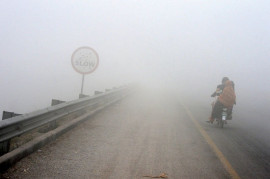
But things have changed over the years. Islamabad has acquired more of a personality: a very urban one with its various attendant issues. The population has topped a million, and congestion, pollution and water and sanitation concerns have begun to pop up. Small, illegal shantytowns have sprung up, juxtaposed with elite mansions in some cases. Heavy crowds throng the city’s commercial and recreational spots. Newer sectors –residential plots, high-rise apartments and commercial hubs – have emerged, often at the cost of the natural verdancy the town prides itself in.
To relieve growing traffic logjams – and ensure swift VVIP movement – a nexus of wide, interlocking roads and avenues has been laid out. A major project is underway at Zero Point – the traditional starting point for the town itself – which comprises yet another asphalt-and-concrete invasion of the once pristine Shakarparian Hills and contiguous swaths of greenery. We’d never know the details of trees and wildlife sacrificed to accommodate all this “progress” and “development”, nor would the debate about whether the common commuter really needed this multi-tiered, multi-laned plexus of tarmac reach any satisfactory conclusions. But this is only one insult to environmental injury; the hills have already been ravaged by a needless monument to the country, and another is reputedly in the offing — this one to honour the country’s favourite slain leader. We are truly monumental people, apparently.
There are other state-sponsored eyesores in the capital. One prominent roundabout boasts a large, missile: a priapic tribute to our martial potency. Elsewhere, a replica of the rugged Balochi hills we blasted to showcase our nuclear might admonishes all visitors never to mess with us. And then we have the usual political adverts that successive governments and their toadies blotch the city with: typically, billboards featuring larger-than-life, prodigiously-moustached and airbrushed political wannabes endorsing and extolling their (current) party’s (current) leadership in maudlin tones, offering themselves up for the forthcoming elections with ingratiating, tawdry smiles. In aesthetic terms, at least, they firmly put the “bad” back in Islamabad.
These occasional blemishes aside, the capital remains a beautiful place. Despite its brushes with mismanagement and corruption, the Capital Development Authority deserves credit for trying to balance urbanisation with a degree of environmental conservationism. The town is still, easily, the cleanest and most verdant in the country. Parks abound, recreational facilities serve their purpose and top-notch eateries have burgeoned in recent years. Likewise, after years of bureaucratic stupor, stuffiness and officially-imposed conservatism, the capital has slowly begun to exert its cultural presence. Theatre groups and music bands – indigenous, national, international – showcase their talents every now and then. As do fashion designers and artists. Despite recent tragedies and threats from zealots and bigots, despite all the barricades and roadblocks, Islamabad’s denizens continue to ply their lives with a degree of stoicism, and the city continues to acquire and exhibit a distinct socio-cultural flair.
Happy fiftieth, Islamabad. May you have many more.
Published in The Express Tribune, October 4th, 2010.
















1734778885-0/Untitled-(10)1734778885-0-270x192.webp)






COMMENTS (2)
Comments are moderated and generally will be posted if they are on-topic and not abusive.
For more information, please see our Comments FAQ